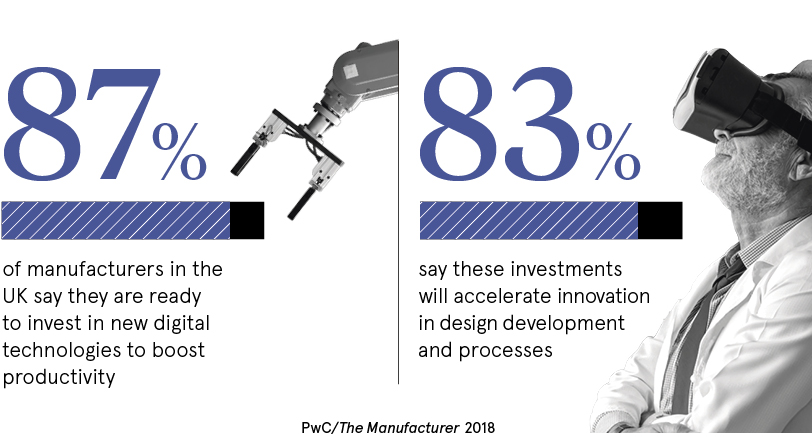Engineering firm BGB Innovation, based in Grantham, Lincolnshire, recently opened a state-of-the-art testing facility to make its product development process more flexible and responsive. Faced with competition in the wind energy sector, from low-cost and low-price competitors in southeast Asia, the company realised it had to increase investment in its research and development (R&D) to ensure the business continues to attract global customers.
“Investing in a hardware facility has enabled us to implement a high level of prototype evaluation and quality control,” says Paul Holdsworth, programme director at BGB. “Although the overall aim is to test hardware prototypes, software has been key to making sure the product development process is effective.”
Mr Holdsworth adds that, with increasing levels of automation, it will ultimately be the software which drives the new testing facility and R&D forward.
Investing in both hardware and software is critical for innovation
Smart manufacturing and smart factories are expected to have driven a 27 per cent increase in efficiency in the manufacturing industry between 2017 and 2022, according to a report by global professional services firm Capgemini. While every manufacturer will be unique in how it operates, they’ll all be working with the same universal goal in mind: to optimise processes, move faster and, most importantly, deliver products and services to customers seamlessly.
The speed at which a factory moves will largely depend on R&D teams being given the flexibility and freedom to innovate. For innovation to occur, investments need to be made in hardware and software. Getting this balance right can be tricky.
“Investment priorities are individual to each company. Generally, though, manufacturers need to consider both hardware and software,” says John Mapother, principal analyst at R&D tax specialists The MPA Group. “Despite software being seen as the more newsworthy and fashionable of the two, it often needs adequate, accompanying hardware to reach its full potential and vice versa.”
To illustrate his point, he gives the example of a manufacturer investing in the most brilliant piece of robotics to help assemble goods. Without the robotic arm – hardware – fitted or installed with the relevant technology – software – its data is of no value. Likewise, without software to monitor and track the arm’s performance and efficiency, the hardware is redundant.
Hardware and software equally important for mechanics
Martin Walder, vice president of industry at Schneider Electric, which specialises in energy management and automation solutions, agrees. He insists: “Good mechanics can’t perform without good software.”
Underlining the need for robust hardware, Robert Sinfield, vice president of product for Sage Business Cloud Enterprise Management, argues that hardware should be seen as the heart of any manufacturing operation. It shouldn’t be overlooked.
“Hardware is essential to the core business; better machines make better products,” he says, adding that there is a caveat. “However, hardware can’t tell you what’s working and what’s not. It can’t give you the insight you need to understand operations better.”
If hardware is the heart of a company, pumping the innovative blood around the metaphorical body, then software can be seen as the nervous system. Its role is to check all parts are operating correctly and send signals when it detects that something’s wrong.
“An enterprise resource planning (ERP) solution acts as the nerve centre. It’s fundamental for informed decision-making and means business strategies can be based on facts, not hunches,” says Nick Castellina, director of industry and solution strategy at software company Infor. “Without the right insight being generated by a suitable ERP solution, investment in machinery can be counterproductive and cause more headaches than it does help [to soothe].”

Innovative software can monitor hardware and help keep it running
With manufacturers under increasing pressure to deliver and ship products faster, with some assembly lines running around the clock, even the slightest delays or downtime can eat into the bottom line. For this reason, manufacturers can’t risk machinery or equipment failing.
Thanks to built-in artificial intelligence, software solutions can learn about every asset’s performance, health and lifespan. This means red flags can be raised and interventions taken before any notable impact on production occurs.
“Software’s ability to connect devices to centralised asset management systems means that it can now warn of impending failure,” explains Mr Walder. “This allows repairs to be planned and carried out in a controlled manner outside scheduled production runs or replacements ordered ahead of time.”
Cinzia Giannetti, senior lecturer at the College of Engineering, Swansea University, and an expert in smart manufacturing and sensors technologies, believes that because software enables predictive maintenance to be carried out, it might not always be necessary to upgrade hardware or buy new machinery and equipment.
“It may be more viable to retrofit existing [hardware] with sensors, communication and computing capabilities,” says Dr Giannetti. “By deploying technologies, such as edge computing, you help to optimise data transmission and processing in the factory. In turn, this allows for enhanced equipment utilisation.”
For real innovation hardware and software need to work together
Deciding between hardware and software is a constant balancing act. The way manufacturers should determine what to invest more in, argues Mr Walder, is to work out which of the two is going to deliver the higher return on investment for the business strategy.
“The latest hardware offers a quick win, helping to ensure the production line works as quickly and efficiently as possible,” he says. “On the other hand, software offers long-term value; investing more in software is effectively future-proofing the business.
“You must remember, software is the key to unlocking the productivity puzzle, but it needs to work alongside hardware on the factory floor, which itself needs to be capable of running reliably.”
